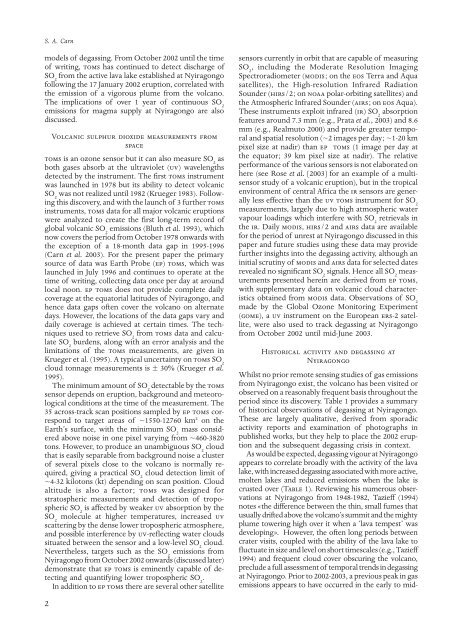eruptive and passive degassing of sulphur dioxide at nyiragongo ...
eruptive and passive degassing of sulphur dioxide at nyiragongo ...
eruptive and passive degassing of sulphur dioxide at nyiragongo ...
Create successful ePaper yourself
Turn your PDF publications into a flip-book with our unique Google optimized e-Paper software.
S. A. Carnmodels <strong>of</strong> <strong>degassing</strong>. From October 2002 until the time<strong>of</strong> writing, toms has continued to detect discharge <strong>of</strong>SO 2from the active lava lake established <strong>at</strong> Nyiragong<strong>of</strong>ollowing the 17 January 2002 eruption, correl<strong>at</strong>ed withthe emission <strong>of</strong> a vigorous plume from the volcano.The implic<strong>at</strong>ions <strong>of</strong> over 1 year <strong>of</strong> continuous SO 2emissions for magma supply <strong>at</strong> Nyiragongo are alsodiscussed.Volcanic <strong>sulphur</strong> <strong>dioxide</strong> measurements fromspacetoms is an ozone sensor but it can also measure SO 2asboth gases absorb <strong>at</strong> the ultraviolet (uv) wavelengthsdetected by the instrument. The first toms instrumentwas launched in 1978 but its ability to detect volcanicSO 2was not realized until 1982 (Krueger 1983). Followingthis discovery, <strong>and</strong> with the launch <strong>of</strong> 3 further tomsinstruments, toms d<strong>at</strong>a for all major volcanic eruptionswere analyzed to cre<strong>at</strong>e the first long-term record <strong>of</strong>global volcanic SO 2emissions (Bluth et al. 1993), whichnow covers the period from October 1978 onwards withthe exception <strong>of</strong> a 18-month d<strong>at</strong>a gap in 1995-1996(Carn et al. 2003). For the present paper the primarysource <strong>of</strong> d<strong>at</strong>a was Earth Probe (ep) toms, which waslaunched in July 1996 <strong>and</strong> continues to oper<strong>at</strong>e <strong>at</strong> thetime <strong>of</strong> writing, collecting d<strong>at</strong>a once per day <strong>at</strong> aroundlocal noon. ep toms does not provide complete dailycoverage <strong>at</strong> the equ<strong>at</strong>orial l<strong>at</strong>itudes <strong>of</strong> Nyiragongo, <strong>and</strong>hence d<strong>at</strong>a gaps <strong>of</strong>ten cover the volcano on altern<strong>at</strong>edays. However, the loc<strong>at</strong>ions <strong>of</strong> the d<strong>at</strong>a gaps vary <strong>and</strong>daily coverage is achieved <strong>at</strong> certain times. The techniquesused to retrieve SO 2from toms d<strong>at</strong>a <strong>and</strong> calcul<strong>at</strong>eSO 2burdens, along with an error analysis <strong>and</strong> thelimit<strong>at</strong>ions <strong>of</strong> the toms measurements, are given inKrueger et al. (1995). A typical uncertainty on toms SO 2cloud tonnage measurements is ± 30% (Krueger et al.1995).The minimum amount <strong>of</strong> SO 2detectable by the tomssensor depends on eruption, background <strong>and</strong> meteorologicalconditions <strong>at</strong> the time <strong>of</strong> the measurement. The35 across-track scan positions sampled by ep toms correspondto target areas <strong>of</strong> ~1550-12760 km 2 on theEarth’s surface, with the minimum SO 2mass consideredabove noise in one pixel varying from ~460-3820tons. However, to produce an unambiguous SO 2cloudth<strong>at</strong> is easily separable from background noise a cluster<strong>of</strong> several pixels close to the volcano is normally required,giving a practical SO 2cloud detection limit <strong>of</strong>~4-32 kilotons (kt) depending on scan position. Cloudaltitude is also a factor; toms was designed forstr<strong>at</strong>ospheric measurements <strong>and</strong> detection <strong>of</strong> troposphericSO 2is affected by weaker uv absorption by theSO 2molecule <strong>at</strong> higher temper<strong>at</strong>ures, increased uvsc<strong>at</strong>tering by the dense lower tropospheric <strong>at</strong>mosphere,<strong>and</strong> possible interference by uv-reflecting w<strong>at</strong>er cloudssitu<strong>at</strong>ed between the sensor <strong>and</strong> a low-level SO 2cloud.Nevertheless, targets such as the SO 2emissions fromNyiragongo from October 2002 onwards (discussed l<strong>at</strong>er)demonstr<strong>at</strong>e th<strong>at</strong> ep toms is eminently capable <strong>of</strong> detecting<strong>and</strong> quantifying lower tropospheric SO 2.In addition to ep toms there are several other s<strong>at</strong>ellitesensors currently in orbit th<strong>at</strong> are capable <strong>of</strong> measuringSO 2, including the Moder<strong>at</strong>e Resolution ImagingSpectroradiometer (modis; on the eos Terra <strong>and</strong> Aquas<strong>at</strong>ellites), the High-resolution Infrared Radi<strong>at</strong>ionSounder (hirs/2; on noaa polar-orbiting s<strong>at</strong>ellites) <strong>and</strong>the Atmospheric Infrared Sounder (airs; on eos Aqua).These instruments exploit infrared (ir) SO 2absorptionfe<strong>at</strong>ures around 7.3 mm (e.g., Pr<strong>at</strong>a et al., 2003) <strong>and</strong> 8.6mm (e.g., Realmuto 2000) <strong>and</strong> provide gre<strong>at</strong>er temporal<strong>and</strong> sp<strong>at</strong>ial resolution (~2 images per day; ~1-20 kmpixel size <strong>at</strong> nadir) than ep toms (1 image per day <strong>at</strong>the equ<strong>at</strong>or; 39 km pixel size <strong>at</strong> nadir). The rel<strong>at</strong>iveperformance <strong>of</strong> the various sensors is not elabor<strong>at</strong>ed onhere (see Rose et al. [2003] for an example <strong>of</strong> a multisensorstudy <strong>of</strong> a volcanic eruption), but in the tropicalenvironment <strong>of</strong> central Africa the ir sensors are generallyless effective than the uv toms instrument for SO 2measurements, largely due to high <strong>at</strong>mospheric w<strong>at</strong>ervapour loadings which interfere with SO 2retrievals inthe ir. Daily modis, hirs/2 <strong>and</strong> airs d<strong>at</strong>a are availablefor the period <strong>of</strong> unrest <strong>at</strong> Nyiragongo discussed in thispaper <strong>and</strong> future studies using these d<strong>at</strong>a may providefurther insights into the <strong>degassing</strong> activity, although aninitial scrutiny <strong>of</strong> modis <strong>and</strong> airs d<strong>at</strong>a for selected d<strong>at</strong>esrevealed no significant SO 2signals. Hence all SO 2measurementspresented herein are derived from ep toms,with supplementary d<strong>at</strong>a on volcanic cloud characteristicsobtained from modis d<strong>at</strong>a. Observ<strong>at</strong>ions <strong>of</strong> SO 2made by the Global Ozone Monitoring Experiment(gome), a uv instrument on the European ers-2 s<strong>at</strong>ellite,were also used to track <strong>degassing</strong> <strong>at</strong> Nyiragong<strong>of</strong>rom October 2002 until mid-June 2003.Historical activity <strong>and</strong> <strong>degassing</strong> <strong>at</strong>NyiragongoWhilst no prior remote sensing studies <strong>of</strong> gas emissionsfrom Nyiragongo exist, the volcano has been visited orobserved on a reasonably frequent basis throughout theperiod since its discovery. Table 1 provides a summary<strong>of</strong> historical observ<strong>at</strong>ions <strong>of</strong> <strong>degassing</strong> <strong>at</strong> Nyiragongo.These are largely qualit<strong>at</strong>ive, derived from sporadicactivity reports <strong>and</strong> examin<strong>at</strong>ion <strong>of</strong> photographs inpublished works, but they help to place the 2002 eruption<strong>and</strong> the subsequent <strong>degassing</strong> crisis in context.As would be expected, <strong>degassing</strong> vigour <strong>at</strong> Nyiragongoappears to correl<strong>at</strong>e broadly with the activity <strong>of</strong> the lavalake, with increased <strong>degassing</strong> associ<strong>at</strong>ed with more active,molten lakes <strong>and</strong> reduced emissions when the lake iscrusted over (Table 1). Reviewing his numerous observ<strong>at</strong>ions<strong>at</strong> Nyiragongo from 1948-1982, Tazieff (1994)notes «the difference between the thin, small fumes th<strong>at</strong>usually drifted above the volcano’s summit <strong>and</strong> the mightyplume towering high over it when a ‘lava tempest’ wasdeveloping». However, the <strong>of</strong>ten long periods betweencr<strong>at</strong>er visits, coupled with the ability <strong>of</strong> the lava lake t<strong>of</strong>luctu<strong>at</strong>e in size <strong>and</strong> level on short timescales (e.g., Tazieff1994) <strong>and</strong> frequent cloud cover obscuring the volcano,preclude a full assessment <strong>of</strong> temporal trends in <strong>degassing</strong><strong>at</strong> Nyiragongo. Prior to 2002-2003, a previous peak in gasemissions appears to have occurred in the early to mid-2
















